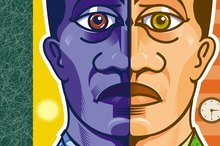What does fact checked mean?
At Healthfully, we strive to deliver objective content that is accurate and up-to-date. Our team periodically reviews articles in order to ensure content quality. The sources cited below consist of evidence from peer-reviewed journals, prominent medical organizations, academic associations, and government data.
The information contained on this site is for informational purposes only, and should not be used as a substitute for the advice of a professional health care provider. Please check with the appropriate physician regarding health questions and concerns. Although we strive to deliver accurate and up-to-date information, no guarantee to that effect is made.
Adolescence is a period of storm and stress in which most adolescents experience emotional turmoil and mental health disturbances, according to Massachusetts General Hospital for Children 2. Changes occurring rapidly in the young person’s life can bring mental difficulties, which produce physiological symptoms.
If you are experiencing serious medical symptoms, seek emergency treatment immediately.
Hypochondriasis in Teenagers
Although hypochondriasis is rare in teenagers, many similar disorders are commonly diagnosed. Hypochondriasis in teenagers tends to overlap with a teenager’s pronounced preoccupation with bodily events. Many teenagers experience persistent concerns about headaches, dizziness and other strange sensations that cannot be explained by a medical diagnosis.
Body Image and Hypochondriasis
Stages of Development Changes From Adolescence Through Adulthood
Learn More
Somatic delusions about a teenager’s body are one of the most common forms of disorders. Because of widespread unhappiness about body image, fixed beliefs can often occur about bodily functions. These beliefs -- which become ingrained in the child’s mind -- can lead to somatoform disorders, which are false, fixed beliefs about the body’s functions without evidence of an actual disease. In addition, these fixed beliefs can lead to serious conditions including anorexia nervosa or bulimia nervosa.
- Somatic delusions about a teenager’s body are one of the most common forms of disorders.
- These beliefs -- which become ingrained in the child’s mind -- can lead to somatoform disorders, which are false, fixed beliefs about the body’s functions without evidence of an actual disease.
Somatoform and Factitious Disorders
Adolescents with somatoform disorders often believe with vivid imagery that something specific is wrong with their body even if a doctor finds no abnormality. Often in teens, somatic symptoms are hidden from doctors due to a possible embarrassment of symptoms they feel, Wells states. This can lead to further anxiety regarding the problem and possible obsessive and compulsive behaviors.
Additional Problems Related to Hypochondriasis
What Is the Difference Between Psychological & Mental Problems?
Learn More
Because of heightened anxiety levels resulting from emotional changes in teenagers, other disorders can arise from somatic delusions and hypochondriac behaviors. While somatic delusions often start slowly, where teenagers believe something small may be wrong with them, they often result in much bigger problems and can cause extremely heightened anxiety levels. Often, these delusions can lead to adolescent depressive symptoms and obsessive-compulsive disorder. In addition, the heightened anxiety can lead to social anxiety disorders and panic disorder -- if somatic delusions are not addressed.
- Because of heightened anxiety levels resulting from emotional changes in teenagers, other disorders can arise from somatic delusions and hypochondriac behaviors.
- In addition, the heightened anxiety can lead to social anxiety disorders and panic disorder -- if somatic delusions are not addressed.
Related Articles
References
- Child Study Center: Psychosomatic Illness in Children and Adolescents (Somatoform Disorders)
- Massachusetts General Hospital: Mental Health Disorders in Children and Teens
- Cleveland Clinic: Body Dysmorphic Disorder
- Eterović M, Kozarić-Kovačić D. Cognitive impairments may mimic delusions. Med Hypotheses. 2015;85(6):870-873. doi:10.1016/j.mehy.2015.09.021
- Cermolacce M, Sass L, Parnas J. What is bizarre in bizarre delusions? A critical review. Schizophr Bull. 2010;36(4):667‐679. doi:10.1093/schbul/sbq001
- Cleveland Clinic. Delusional disorder. Updated January 23, 2018.
- González-Rodríguez A, Esteve M, Álvarez A, et al. What we know and still need to know about gender aspects of delusional disorder: a narrative review of recent work. J Psychiatry Brain Sci. 2019;4:e190009. doi:10.20900/jpbs.20190009
- Pepper EJ, Pathmanathan S, Mcilrae S, Rehman FU, Cardno AG. Associations between risk factors for schizophrenia and concordance in four monozygotic twin samples. Am J Med Genet B Neuropsychiatr Genet. 2018;177(5):503-510. doi:10.1002/ajmg.b.32640
- Joyce EM. Organic psychosis: the pathobiology and treatment of delusions. CNS Neurosci Ther. 2018;24(7):598-603. doi:10.1111/cns.12973
- Nygaard M, Sonne C, Carlsson J. Secondary psychotic features in refugees diagnosed with post-traumatic stress disorder: A retrospective cohort study. BMC Psychiatry. 2017;17(1):5. doi:10.1186/s12888-016-1166-1
- U.S. National Library of Medicine, MedlinePlus. Brief psychotic disorder. Updated March 26, 2018.
- Qian W, Fischer CE, Churchill NW, Kumar S, Rajji T, Schweizer TA. Delusions in Alzheimer disease are associated with decreased default mode network functional connectivity. Am J Geriatr Psychiatry. 2019;27(10):1060-1068. doi:10.1016/j.jagp.2019.03.020
- Taddei RN, Cankaya S, Dhaliwal S, Chaudhuri KR. Management of psychosis in Parkinson's disease: Emphasizing clinical subtypes and pathophysiological mechanisms of the condition. Parkinsons Dis. 2017;2017:3256542. doi:10.1155/2017/3256542
- Wesseloo R, Kamperman AM, Munk-Olsen T, Pop VJ, Kushner SA, Bergink V. Risk of postpartum relapse in bipolar disorder and postpartum psychosis: A systematic review and meta-analysis. Am J Psychiatry. 2016;173(2):117-127. doi:10.1176/appi.ajp.2015.15010124
- U.S. National Library of Medicine, Genetics Home Reference. Schizoaffective disorder. Updated February 11, 2020.
- National Institute of Mental Health. Schizophrenia. Updated February 2016.
- Knapp B, Tito E, Espiridion ED. Delusional parasitosis in a patient with alcohol-induced psychotic disorder. Cureus. 2019;11(3):e4344. doi:10.7759/cureus.4344
- Cleveland Clinic. Delusional Disorder: Diagnosis and Tests. Updated January 22, 2018.
- Cleveland Clinic. Delusional Disorder: Management and Treatment. Updated January 23, 2018.
- Mehl S, Werner D, Lincoln TM. Corrigendum: Does cognitive behavior therapy for psychosis (CBTp) show a sustainable effect on delusions? A meta-analysis. Front Psychol. 2019;10:1868. doi:10.3389/fpsyg.2015.01450
- American Psychiatric Association. Diagnostic and statistical manual of mental disorders. 5th ed. 2013. doi:10.1176/appi.books.9780890425596
- Bürgy M. Study of delusional depression: Drive, dynamics, therapy. Neurol Psychiatry Brain Res. 2018;30:117-124. doi:10.1016/j.npbr.2018.08.003
- Hoenders HJR, Bartels-Velthuis AA, Vollbehr NK, Bruggeman R, Knegtering H, de Jong JTVM. Natural medicines for psychotic disorders: A systematic review. J Nerv Ment Dis. 2018;206(2):81-101. doi:10.1097/NMD.0000000000000782
Writer Bio
Kenneth D. Hartline is a Doctor of Psychology student at Pepperdine University in Los Angeles, California. He is also the founder and CEO of Hartline Enterprises LLC, a mental performance consulting agency. In 2009 he graduated from the University of Oregon with dual bachelor's degrees in journalism and psychology and has been writing professionally since 2007.









